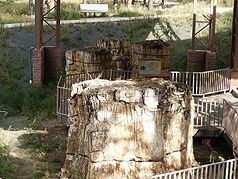Florissant Fossil Beds National Monument
| Florissant Fossil Beds National Monument | ||
|---|---|---|
| Sequoia fossils | ||
|
|
||
| Location: | Colorado , United States | |
| Next city: | Florissant (Colorado) | |
| Surface: | 24.3 km² | |
| Founding: | 20th August , 1969 | |
| Visitors: | 62,417 (2004) | |
The Florissant Fossil Beds National Monument is located in the US state of Colorado . It is located in Teller County 35 miles west of Colorado Springs not far from Pikes Peak . On August 20, 1969, this area was declared a National Monument. It covers an area of 24 km² and is at an altitude of 2560 m.
In a high valley west of Pikes Peak, evidence of past life on earth can be found in the form of petrified trees and well-preserved fossils of insects and plants. Here is one of the largest and most diverse collections of fossils in the world, ranging from the tiniest insect to massive petrified sequoia trees . Around 1700 different animal and plant species have been identified so far.
Geological history
Florissant is the only known location of the flora of the central Rocky Mountains region from the upheaval between Eocene and Oligocene about 34 million years ago. The finds from Florissant stand between those of the 48 million year old Green River Formation and the much more recent finds near Creede , Colorado from the Pliocene about 5 million years ago. They give insights into the climatic and other environmental conditions and allow the developments in the Rocky Mountains region to be recorded. In addition, the finds of both flora and fauna are extraordinarily rich in species and individual and represent the world's best discovery site from its time.
At the end of the Eocene, Lake Florissant, a 24 km long lake, dominated the wooded valley. Lush ferns and bushes thrived under towering redwoods , arborvitae , pines and deciduous trees such as maples , oaks and hickories . Thousands of insects of all kinds lived in this warm, humid climate. Fish cavorted in the lake and mollusks, birds and mammals populated its banks.
About 35 million years ago a volcanic eruption buried the entire valley under millions of tons of volcanic ash, dust and pumice rock. Over a period of around 700,000 years there were always new eruptions. The remains of plants and animals were buried at the bottom of the prehistoric lake and preserved as fossils.
Flora and fauna
Today the area of the Florissant Fossil Beds National Monument is a landscape of meadows and forests. Pine, fir, spruce and aspens are the most common trees. Large mammals such as elk , mule deer, bears , mountain lions , foxes and coyotes live here. Birds of prey hunt squirrels and mice.
visit
The Florissant Fossil Beds National Monument has a visitor center that offers lots of information about flora, fauna, and fossils.
Web links
- National Park Service: Florissant Fossil Beds National Monument (official site; English)
Individual evidence
- ^ RM Hutchinson, KE Kolm: The Florissant Fossil Beds National Monument, Teller County, Colorado . In: Geological Society of America, Centennial Field Guide - Rocky Mountain Section , Volume 2. Boulder, Colorado, Geological Society of America, 1987, ISBN 0-8137-5406-2 , pp. 329f.

